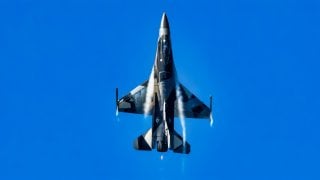F-16 Fighters Will Fly For Argentina With U.S. Weapons
The Lockheed Martin-produced F-16 Fighting Falcon will soon be a South American warbird, as the U.S. State Department approved the Foreign Military Sale to the Government of Argentina for the multirole combat aircraft this week. Buenos Aires had requested twenty-four F-16 Block 10/15 aircraft that would be delivered via a third-party transfer.
The Lockheed Martin-produced F-16 Fighting Falcon will soon be a South American warbird, as the U.S. State Department approved the Foreign Military Sale to the Government of Argentina for the multirole combat aircraft this week. Buenos Aires had requested twenty-four F-16 Block 10/15 aircraft that would be delivered via a third-party transfer.

Last year, the U.S. approved Argentina acquisition of the two dozen F-16s from Denmark, in a deal valued at $320 million.
Support Deal
The newly announced $941 million contract will see Argentina receiving thirty-six AIM-120 C-8 Advanced Medium Range Air-to-Air Missiles (AMRAAM), 102 MK-82 500 pound general purpose bombs, 50 GBU-12 Paveway II laser-guided bombs and assorted other ordnance, as well as communication and navigation equipment, spare parts, ground support systems, and technical support for the Block 10/15 Fighting Falcons.
Lockheed Martin will be the principal contractor for the deal and will oversee the modernization of the fighters.
"This proposed sale will support the foreign policy goals and national security objectives of the United States by improving the security of a major non-NATO ally that is a force for political stability and economic progress in South America," the Defense Security Cooperation Agency (DSCA) explained.

"The proposed sale will improve Argentina's capability to meet current and future threats by providing the additional capacity to conduct air defense, offensive counter air, and close air support operations. Argentina will have no difficulty absorbing this equipment into its armed forces," DSCA added. "The proposed sale of this equipment and support will not alter the basic military balance in the region."
Blocking Russia and China with F-16
Though the DSCA didn't specify as much, the decision to approve the transfer of the Danish F-16 Fighting Falcons has been seen as blocking Buenos Aires from closing any deals with Beijing or Moscow.
While Argentine Minister of Defense Luis Afonso Petri described the F-16s in April as "the best aircraft at that fly in the skies of the South American region and the world," Argentina had also expressed interest in the Russian-made Sukhoi Su-24 (NATO reporting name Fencer) and Chinese-Pakistani JF-17 Thunder jet fighters.

Beijing worked with Islamabad on the Thunder, which has been marketed to the developing world as a low-cost combat aircraft.
Had China succeeded in selling its jets to Argentina – along with other weapons including armored vehicles – Beijing almost certainly would have gained entry into the country's defense and security infrastructure. Even worse for Washington, it might not have just been Argentina that could have adopted the JF-17 and other Chinese hardware.
Rick Fisher, a senior fellow at the Washington-based International Assessment and Strategy Center, told Voice of America earlier this year that "other Latin American countries would have been encouraged to follow in its footsteps."
Instead, the F-16 will fly for Argentina.
Author Experience and Expertise: Peter Suciu
Peter Suciu is a Michigan-based writer. He has contributed to more than four dozen magazines, newspapers, and websites with over 3,200 published pieces over a twenty-year career in journalism. He regularly writes about military hardware, firearms history, cybersecurity, politics, and international affairs. Peter is also a Contributing Writer for Forbes and Clearance Jobs. You can follow him on Twitter: @PeterSuciu. You can email the author: [email protected].
Image Credit: Creative Commons and/or Shutterstock.


